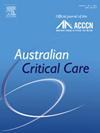Airborne personal protective equipment availability and preparedness in Australian and New Zealand intensive care units: A point prevalence survey
IF 2.6
3区 医学
Q2 CRITICAL CARE MEDICINE
引用次数: 0
Abstract
Background
Personal protective equipment is essential to protect healthcare workers when exposed to aerosol-generating procedures in patients with airborne respiratory pathogens.
Aim
This study aimed to provide information regarding the level of airborne protection offered to nursing staff and other healthcare workers in Australian and New Zealand intensive care units (ICUs) 1 year into the coronavirus disease 2019 pandemic.
Methods
In this cross-sectional survey, ICUs in Australia and New Zealand were asked to participate in the Australian and New Zealand Intensive Care Society Clinical Trials Group Point Prevalence Program in June 2021. Sites were asked to contribute to questions regarding airborne protection offered to nursing staff and other healthcare workers.
Results
There were 51 participating sites. Negative-pressure bed space availability within participating ICUs included 24 with more than two, 15 with two, eight with one, and one ICU that did not have any. The median (interquartile range) number of different models and sizes of N95/P2 masks available to ICU staff was 6 (4–7). Of the 1018 nursing staff working that day in the units, 799 (78.5%) had at least one fit-tested N95/P2 mask in the correct size available. A total of 712 patients (461 medical and 251 surgical) were cared for by 700 bedside nurses in these ICUs. Overall, adequate airborne protection preparedness (airborne personal protective equipment training and fit-testing since the pandemic) was present in 548 (78.3%) bedside nurses.
Conclusions
Over a year into the coronavirus disease 2019 pandemic, airborne protection provided to nursing and other healthcare staff in Australia and New Zealand was often inadequate.
澳大利亚和新西兰重症监护病房机载个人防护装备的可用性和准备情况:一项点流行调查。
背景:个人防护装备对于在空气传播呼吸道病原体患者中接触产生气溶胶的程序时保护卫生保健工作者至关重要。目的:本研究旨在提供有关澳大利亚和新西兰重症监护病房(icu)护理人员和其他医护人员在2019冠状病毒病大流行一年后的空气传播保护水平的信息。方法:在这项横断面调查中,澳大利亚和新西兰的icu被要求于2021年6月参加澳大利亚和新西兰重症监护学会临床试验组点流行计划。要求各站点提供有关向护理人员和其他卫生保健工作者提供空气传播保护的问题。结果:共有51个参与点。参与ICU的负压床位可用性包括2个以上的24个,2个的15个,1个的8个,1个没有床位的ICU。ICU工作人员可获得不同型号和尺寸N95/P2口罩的中位数(四分位数间距)为6(4 ~ 7)。当天在各单位工作的1018名护理人员中,799名(78.5%)至少有一个正确尺寸的N95/P2口罩。共有712名患者(461名内科患者和251名外科患者)由700名床边护士在这些icu中护理。总体而言,548名(78.3%)床边护士做好了充分的空中防护准备(大流行以来的空中个人防护装备培训和体能测试)。结论:在2019年冠状病毒病大流行一年多的时间里,澳大利亚和新西兰为护理人员和其他医护人员提供的空气传播保护往往不足。
本文章由计算机程序翻译,如有差异,请以英文原文为准。
求助全文
约1分钟内获得全文
求助全文
来源期刊

Australian Critical Care
NURSING-NURSING
CiteScore
4.90
自引率
9.10%
发文量
148
审稿时长
>12 weeks
期刊介绍:
Australian Critical Care is the official journal of the Australian College of Critical Care Nurses (ACCCN). It is a bi-monthly peer-reviewed journal, providing clinically relevant research, reviews and articles of interest to the critical care community. Australian Critical Care publishes peer-reviewed scholarly papers that report research findings, research-based reviews, discussion papers and commentaries which are of interest to an international readership of critical care practitioners, educators, administrators and researchers. Interprofessional articles are welcomed.
 求助内容:
求助内容: 应助结果提醒方式:
应助结果提醒方式:


